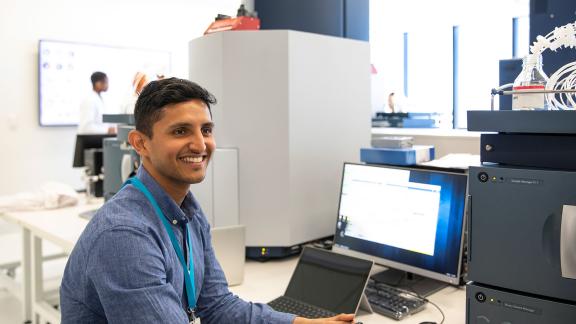Modernising healthcare for people living with dementia and their carers: Surrey and North East Hampshire
Overview
A remote monitoring service has used new technologies to modernise the healthcare system for older patients with long-term health conditions. Launched in July 2020 in response to the COVID-19 pandemic, the service supports people with dementia and their carers, who are often excluded from other remote monitoring services. The service, offered by Surrey and Borders Partnership NHS Foundation Trust, has improved outcomes for patients and carers and led to a reduction in hospital and A&E attendance.
Key benefits and outcomes
- Improved outcomes for patients and their carers
- A reduction in hospital and A&E attendance
- Improved experience for patients and their carers
- Greater personalisation of care
The challenge
The isolation faced by people living with dementia, and their carers, can be associated with physical illness and mental distress for patient and carer; with an increased likelihood of requiring primary care treatment, presentation to urgent and emergency care and hospital admission. This has the compounding impact of increasing the potential for COVID-19 transmission among this already vulnerable group.
The solution
Originally developed in 2016 as part of an NHS England innovation test bed programme, Surrey and Borders’ Technology Health Management (TIHM) remote monitoring service makes use of new technologies to modernise the healthcare system for older patients living with long-term health problems.
It provides people living with dementia and their carers with various equipment, including environmental sensors, smart plugs, a thermometer, a pulse oximeter and a tablet. They are installed by the residents of a household with the assistance of the Howz monitoring service. The outputs are logged onto a tablet device, either manually or via Bluetooth connection, and submitted to a remote monitoring team.
In July 2020, in response to the COVID-19 pandemic, the trusts launched the TIHM remote monitoring service to support people with dementia and their carers who were at a particular risk of becoming isolated and vulnerable during the pandemic. The monitoring equipment had been refined since 2016 to allow families to self-install, with technical support available if needed. This was an important part of the offer in reducing social contact and risk during the first wave of COVID-19. The TIHM service helps carers to understand behaviour change in the context of the person and their environment, highlighting potential problems at an earlier stage and providing a direct link to NHS support.
The TIHM service offers a model of digital healthcare designed specifically for people with dementia who are often excluded from other remote monitoring services. It also provides support to carers, recognising their mental and physical health needs given the burden placed upon them.
Since implementation in July 2020, 540 services users have been enrolled.
Results and benefits
The programme has been economically evaluated by the Kent, Surrey, and Sussex Academic Health Science Network, which found:
- 42 per cent reduction in risk of care home admission
- 60 per cent of informal carers reported a reduction in anxiety
- potential savings of £6.7m over five years, constituting a return on investment of £1.10 for every £1 invested
- when users were asked about their experience of the service, 71 per cent reported it as ‘very good’ or ‘good’; 55 per cent reported a reduction in anxiety and 81 per cent were ‘very likely’ or ‘extremely likely’ to recommend the service.
Overcoming obstacles
One barrier encountered was getting referrals onto the service and in particular embedding TIHM within referral pathways. This was particularly challenging within the COVID-19 climate in which people were inundated with communications and professionals, and services were under immense pressure. This required ongoing communication and engagement, and it continues to be a challenge.
Gaining access to lists of individuals who had been diagnosed with dementia and proactively approaching them was found to be the most successful route to referral, and funding for a TIHM coordinator role to support embedding TIHM in discharges from acute pathways has recently been secured.
Another barrier encountered was ensuring the service was compliant with cyber security, information governance and clinical safety processes. While necessary, these processes were found to be time consuming and took significant resources away from delivery. This was particularly challenging given the pace at which the service was set up and the fact the team were pulling on resources not specifically allocated to this service.
As the team looks to the future, there is a desire to improve the interoperability of TIHM with the core systems used across the integrated care system.
As with any digitalisation of services, there was also the risk of exacerbating existing access inequalities. Two strategies to overcome this are the utilisation of tech volunteers to support the small number of services users who need further in person support and the provision of a Wi-Fi router to those who don’t already have access to the internet in their home.
Takeaway tips
- Ensure the required expertise is fully costed and these professionals are then allocated to similar projects
- Dedicate time to understanding the necessary processes required for successful delivery and ensure they are as streamlined as possible.
Contact details
Professor Helen Rostill, Deputy Chief Executive and Director of Therapies, SABP & Partnership & Executive Director for Mental Health, Surrey Heartlands
International innovations in mental health
Access more examples from across the globe on how mental health services have implemented innovations in response to COVID-19.



